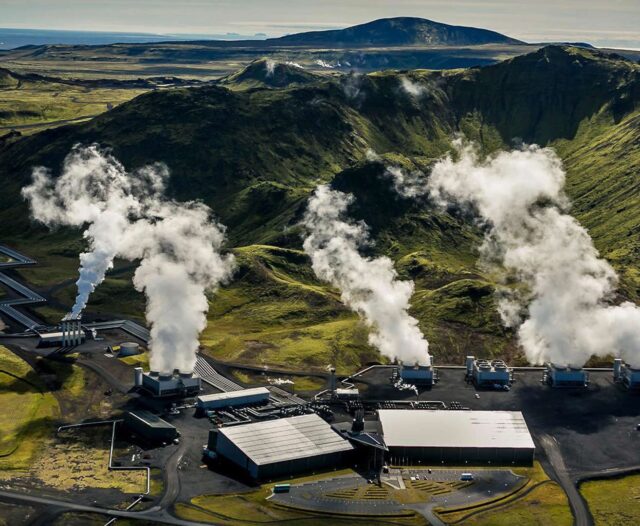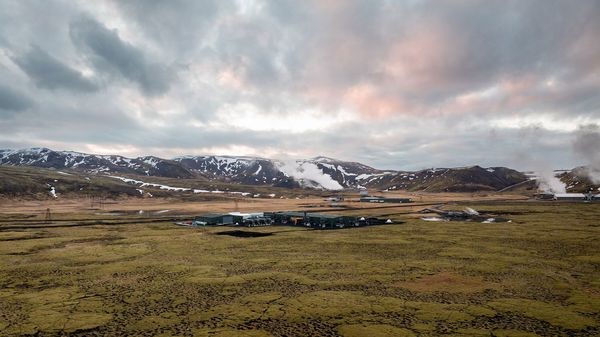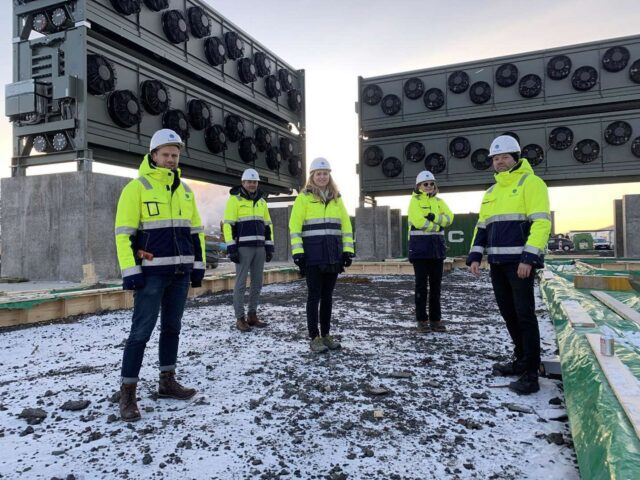The unveiling of the “world’s largest” vacuum, aptly named “Mammoth,” marks a significant milestone in the fight against climate solutions. The Mammoth is currently the world’s largest direct air capture (DAC) plant. It is developed by Swiss company “Climeworks” to act as a giant vacuum, sucking planet-heating carbon dioxide out of the atmosphere.
Located in Iceland, “Mammoth” is the second commercial direct air capture plant opened by Swiss company Climeworks in the country, and is 10 times bigger than its predecessor, Orca, which started running in 2021. However, concerns have been raised about the utilization of captured carbon, particularly in processes like “enhanced oil recovery.” This practice, employed by some companies, raises ethical questions about potentially prolonging fossil fuel extraction.
This article provides insight into the working mechanism of the technology while exploring possible challenges and opportunities. Read on to find out more.
The Need for Innovation
Air pollution remains one of the most pressing environmental challenges of our time. From harmful particulate matter to noxious gasses emitted by vehicles, factories, and other sources, pollutants pose serious risks to human health and the planet. According to the World Health Organization (WHO), outdoor air pollution is responsible for an estimated 7 million premature deaths and results in the loss of millions of life.
Traditional approaches to combating air pollution, such as emission controls and renewable energy initiatives, have made significant strides. However, the scale of the problem demands innovative solutions that can deliver swift and tangible results. Enter the world’s largest vacuum.
According to the International Energy Agency, all the carbon removal equipment in the world is only capable of removing about 0.01 million tonnes of carbon a year, a far cry from the 70 million tons a year needed by 2030 to meet global climate goals. Which is why the inauguration of Mammoth, therefore, signifies a significant leap forward in the pursuit of sustainable technology. The Mammoth however, while groundbreaking, is part of a broader trend toward larger-scale DAC initiatives. Other companies are also investing in DAC technology, with projects like Stratos in Texas poised to remove up to 500,000 tonnes of carbon annually.

Source: 9news
How DAC works?
Direct air capture operates on a simple yet revolutionary principle. Direct air capture, or DAC, is a technology designed to suck in air and strip out the carbon using chemicals. The carbon can then be injected deep beneath the ground, reused or transformed into solid products. Once captured, the carbon is then either injected deep underground, where it undergoes a natural transformation into stone, or repurposed for various applications. Mammoth’s modular design allows for easy movement and stacking of collector containers, enabling efficient operation and scalability. With plans to eventually capture 36,000 tons of carbon annually, Mammoth sets a new standard for carbon removal on a massive scale.
Partnering with Icelandic company Carbfix, Climeworks aims to implement a process known as sequestration, ensuring the captured carbon remains locked away indefinitely. This innovative approach not only mitigates the environmental impact of carbon emissions but also capitalizes on Iceland’s renewable energy infrastructure, further enhancing sustainability.
Climeworks plans to transport the carbon underground, where it will be naturally converted into stone, effectively locking it away from the atmosphere for millennia. This sequestration process, developed in partnership with Icelandic company Carbfix, ensures that the captured carbon remains permanently stored, contributing to long-term climate stabilization efforts.
However, concerns have been raised about the utilization of captured carbon, particularly in processes like “enhanced oil recovery.”
Sustainable Operation
At the heart of Mammoth’s sustainable operation lies its utilization of Iceland’s abundant geothermal energy. Geothermal energy taps into the Earth’s natural heat, sourced from magma deep within the planet’s crust. Iceland, situated atop the Mid-Atlantic Ridge, boasts an extraordinary abundance of geothermal activity, making it an ideal location for renewable energy projects like Mammoth.

Source: msn
Unlike fossil fuels, which release harmful greenhouse gasses when burned, geothermal energy offers a clean and renewable alternative. The process involves extracting heat from underground reservoirs of hot water or steam, which is then used to drive turbines and generate electricity. This closed-loop system produces minimal emissions and has a significantly lower environmental impact compared to traditional energy sources.
Iceland’s unique geological features make it a global leader in geothermal energy production. The country’s geothermal reserves provide a reliable and virtually limitless source of clean power, capable of meeting a substantial portion of its energy needs. Iceland’s commitment to harnessing its geothermal potential has earned it recognition as a pioneer in renewable energy innovation.
By tapping into Iceland’s geothermal resources, Mammoth operates with a minimal carbon footprint, aligning with Climeworks’ commitment to sustainability. The plant’s reliance on renewable energy not only reduces its environmental impact but also sets a precedent for responsible resource management in large-scale industrial operations.
Advantages of Geothermal Energy
Beyond its environmental benefits, geothermal energy offers several advantages that make it an attractive option for powering carbon removal initiatives like Mammoth:
- Reliability: Geothermal energy is available 24/7, providing a consistent and dependable power supply for continuous operation.
- Cost-Effectiveness: While initial investment costs may be higher than fossil fuel-based energy systems, geothermal plants offer long-term savings due to lower operational and maintenance expenses.
- Local Economic Benefits: Developing geothermal resources creates jobs and stimulates economic growth in surrounding communities, fostering sustainable development and energy independence.

Source: cnn
Challenges and Opportunities:
While the potential of Mammoth and similar DAC initiatives is vast, they are not without their challenges and opportunities.
Challenges
- Cost and Affordability: Despite technological advancements, the cost of DAC remains a significant barrier to widespread adoption. Mammoth’s estimated cost per ton of carbon removed, while not disclosed precisely, is closer to $1,000, well above the widely recognized threshold of $100 per ton for viability.
- Energy Consumption: DAC plants require substantial energy inputs to operate efficiently. While Mammoth benefits from Iceland’s geothermal energy, ensuring sustainable and low-carbon operation, energy requirements remain a concern for DAC plants in regions with less access to renewable energy sources.
- Scalability: While Mammoth boasts impressive capacity, the scale of carbon removal required to make a meaningful impact on global emissions is immense. Current DAC technologies, including Mammoth, represent only a fraction of the carbon removal capacity needed to meet ambitious climate targets.
- Ethical Considerations: The potential use of captured carbon for enhanced oil recovery raises ethical questions about the unintended consequences of carbon removal initiatives. Balancing carbon removal with efforts to phase out fossil fuels is crucial to avoiding the perpetuation of unsustainable practices.
The “Enhanced Oil Recovery” Conundrum
“Enhanced oil recovery” (EOR) poses a significant ethical dilemma in the context of carbon capture technologies. While DAC plants like Mammoth offer a means to capture and sequester carbon dioxide, some companies, including those involved in oil production, view captured carbon as a valuable resource for extracting more fossil fuels.
In EOR processes, captured carbon is injected into oil wells to enhance oil recovery from aging fields. While this technique can increase oil extraction efficiency, it perpetuates our reliance on fossil fuels and prolongs the lifespan of carbon-intensive industries. Critics argue that EOR not only undermines the environmental benefits of carbon capture but also exacerbates the root causes of climate change.

Source:
Opportunities:
- Technological Innovation: Continued advancements in DAC technology hold the promise of reducing costs, improving energy efficiency, and enhancing scalability. Research and development efforts aim to optimize DAC processes, making carbon removal more accessible and cost-effective.
- Policy Support: Government policies and incentives play a vital role in fostering the growth of carbon removal technologies. Supportive regulatory frameworks, including carbon pricing mechanisms and subsidies for clean energy, can incentivize investment in DAC and accelerate its deployment.
- Collaborative Partnerships: Collaboration between industry, academia, and governments is essential for driving innovation and overcoming challenges in the DAC sector. Public-private partnerships facilitate knowledge sharing, resource mobilization, and technology transfer, enabling more effective solutions to emerge.
- Climate Finance: Access to climate finance mechanisms, such as carbon markets and green bonds, can provide critical funding for DAC projects. Investments in carbon removal technologies not only mitigate climate risks but also offer financial returns, attracting private capital to the sector.
Adequate response to these challenges and seizing opportunities will be key to realizing the full potential of DAC in addressing climate change. While uncertainties remain, the collective efforts of stakeholders worldwide hold the promise of accelerating the transition to a carbon-neutral future. As Mammoth continues to capture the imagination of innovators and policymakers alike, it serves as a symbol of our shared commitment to combating climate change through innovation, collaboration, and bold action.
A Vision for the Future
Looking ahead, Mammoth represents more than just a technological marvel – it embodies a vision for a carbon-neutral future. Climeworks’ ambitious plans to scale up carbon removal to 1 million tons per year by 2030 and 1 billion tons by 2050 underscore the transformative potential of DAC technology. As Mammoth paves the way for larger-scale carbon removal projects, it serves as a beacon of hope in our collective quest for a sustainable and resilient planet.
In conclusion, Mammoth’s inauguration marks a significant milestone in the fight against climate change. By harnessing innovation, sustainability, and ambition, Mammoth and similar initiatives offer tangible pathways towards a carbon-neutral future. As we navigate the challenges of the 21st century, Mammoth stands as a testament to human ingenuity and our capacity to address the greatest challenges of our time.
About CheckCarbonFact
CheckCarbonFact is a social accountability platform for promoting sustainability and responsible climate action by citizens, businesses and government. Read more about us here: https://checkcarbonfact.com/about/
Carbon Fact for the Day

Found it interesting and would like more in the mail?




